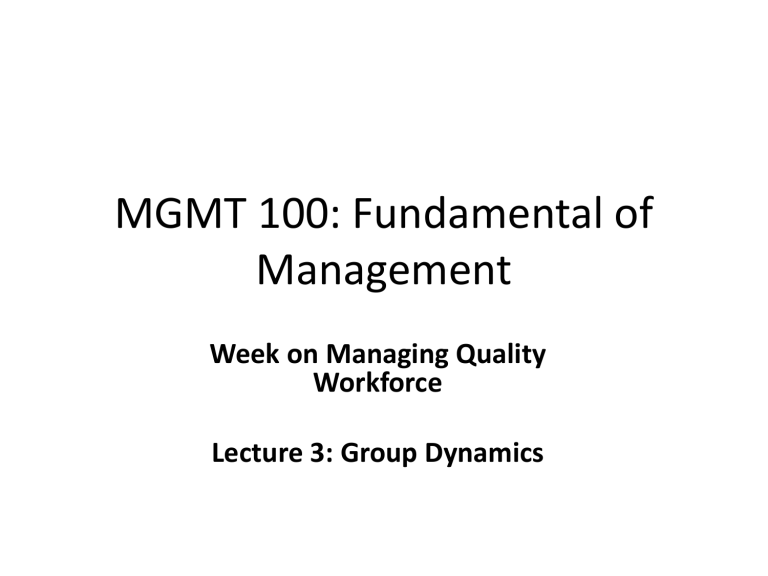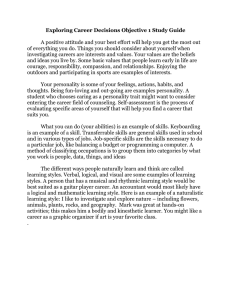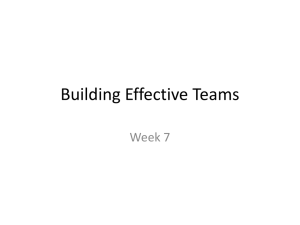
MGMT 100: Fundamental of Management Week on Managing Quality Workforce Lecture 3: Group Dynamics What to expect from today? • Reading: – Daft & Marcic (2017). Understanding management. Cengage. – Pages 594-599; 606-607; 611-623 After completing your study of this topic you should be able to: • Recognise what makes effective teams • Explain organisational context, inputs, team processes, and how they impact work team effectiveness. What is a team? • A unit of two or more people who interact and coordinate their work to accomplish a common goal. • 2 or more people • Complementary skills • Regular interaction • Shared goal, commitment • Mutually accountable Teamwork: The process of people actively working together to accomplish ________________. Model of team effectiveness “Inputs” Model of team effectiveness Fig 14.5 p. 606 Team characteristics Team size • Small teams (2-4) tend to show more agreement, ask more questions and exchange more opinions – Dynamics with small groups of different sizes? • Large teams (12+) tend to have more disagreements and differences in opinion, and are challenging to coordinate – Tend to form subgroups – “two-pizza rule” • No optimal team size (~3-6) • Diversity in skills is key (note concept of synergy later) Team characteristics Team diversity • Different values, personalities, experiences, etc., can create challenges. – E.g., interdisciplinary teams • But with complexity come greater variety of ideas, perspectives and experiences that add value to problem-solving and task performance • Solving initial process challenges ________________ Process Stages of team development Fig 14.7, p. 615 Process Cohesiveness – The degree to which members are attracted to a team and motivated to remain part of a team – Members of highly cohesive teams are often committed to team activities, attend meetings and are happy when the team succeeds. – Beneficial when paired with ___________________________________. Process How to increase team cohesion? – Shared goals. – Increase interaction among members. – Introduce competition with other teams. – Team success Cohesiveness leads to: Better _________ & ___________ Process What can go wrong in teams? – Common problems: • Personality conflicts • Differences in work styles • Task ambiguity Process Conflict Two types of conflict, relating to issues/disagreements on: __________ Substantive issues regarding e.g., goals. ____________. Emotional issues arising from feelings of e.g., distrust, and personality clashes. Conflict that is well managed can help promote high performance, creativity and innovation. Functional conflict Often task conflict Moderately intense conflict Constructive; stimulates people towards greater work efforts, cooperation and creativity. Can prevent _______________ Dysfunctional conflict Often relationship conflict. Low-intensity and very high-intensity conflict Destructive; hurts task performance. Balancing conflict and cooperation Fig 14.9, p. 621 Conflict management styles Fig 14.10; p. 622 Process What can go wrong in teams? – Common problems: • Personality conflicts • Differences in work styles • Task ambiguity • Social loafing Process Social loafing “a reduction in individual effort when working on a collective task compared to when working either alone or coactively” • As group size increases, new members have decreasingly significant impact. • _____________________ Model of team effectiveness “Inputs” Model of team effectiveness Effectiveness Team effectiveness may be summarised by the following equation: Team effectiveness = Quality of inputs + (Process ______ – Process _______) Cohesion, diversity Conflict, social loafing Take home messages




